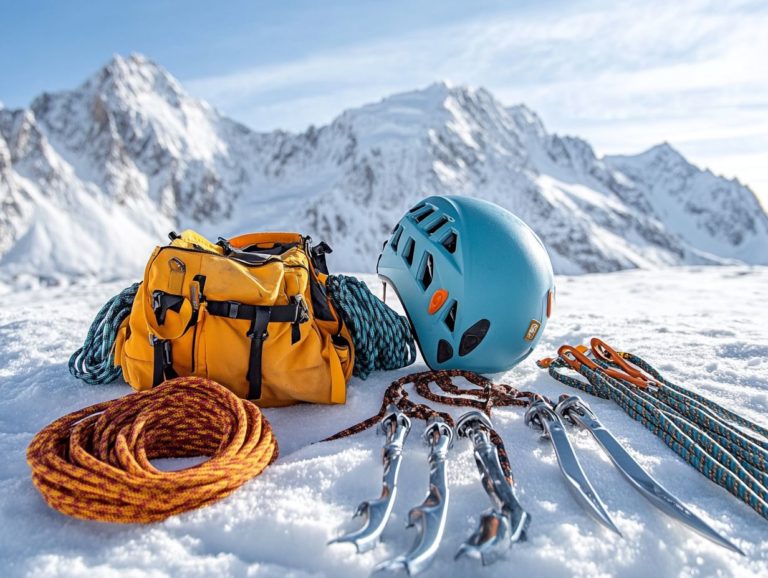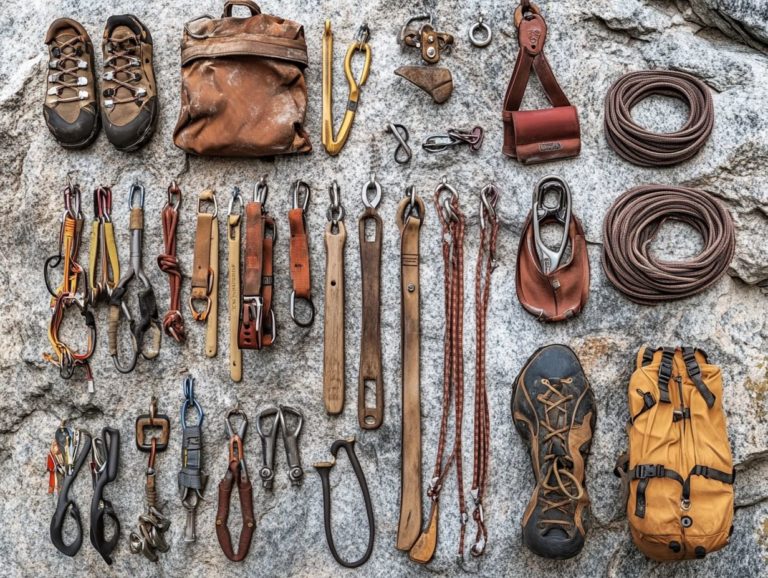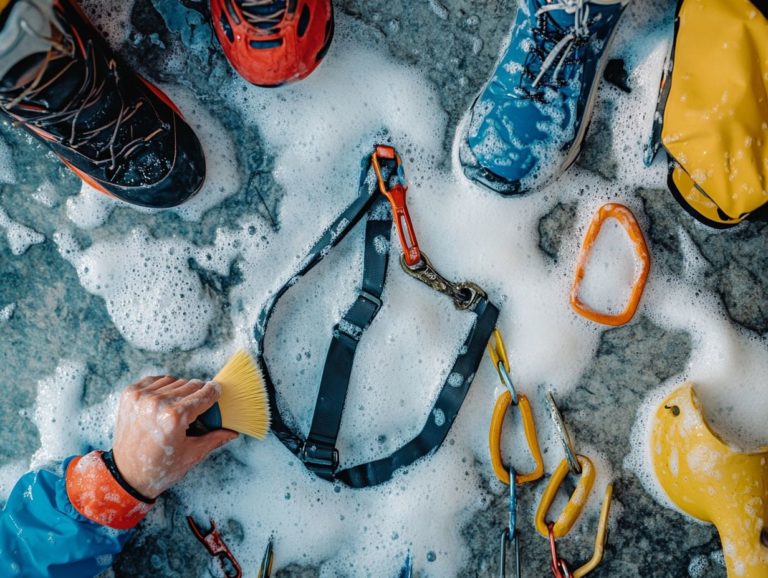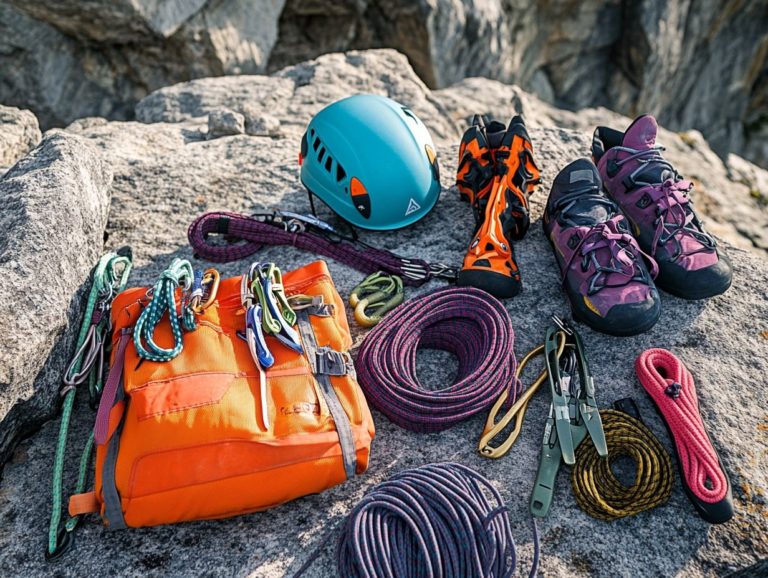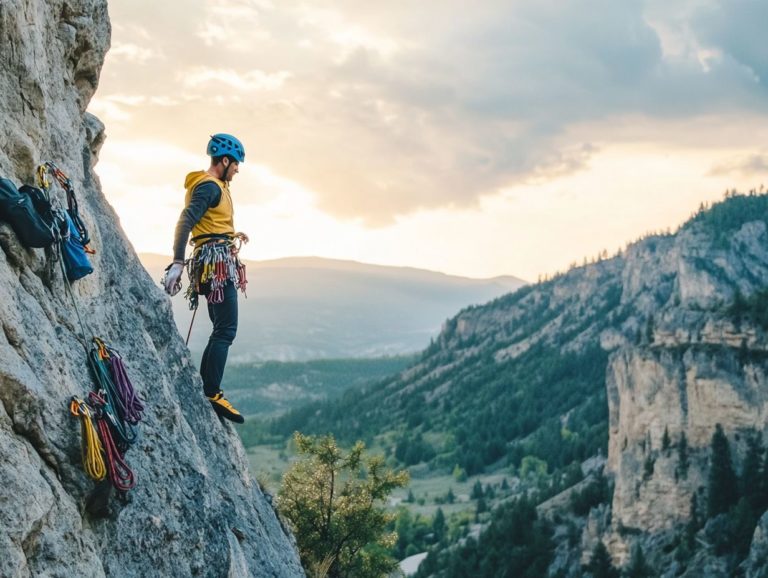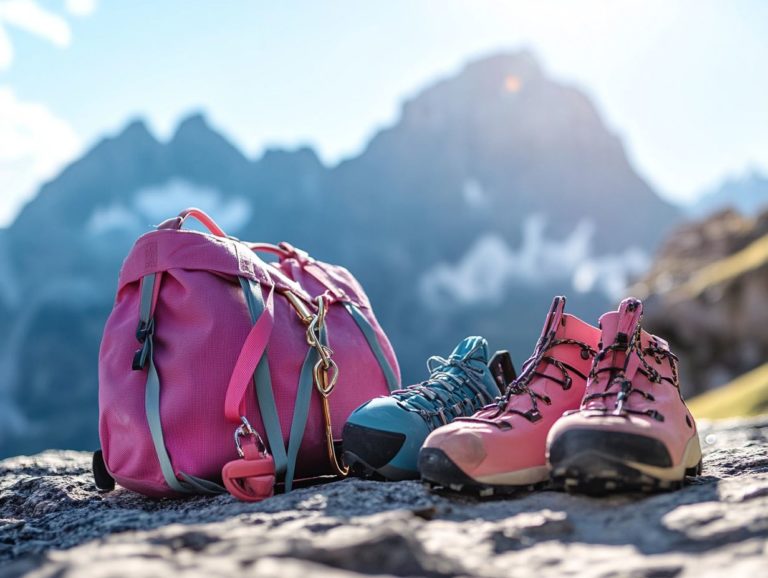The Most Versatile Climbing Gear for Any Trip
Planning a climbing adventure? The right gear is paramount for your safety, comfort, and overall performance.
From climbing shoes to a reliable harness, each item on your checklist is essential for ensuring a successful expedition.
This article delves into the must-have climbing gear, guiding you on how to select equipment tailored to your specific needs, along with valuable tips for maintenance and packing.
Get ready to gear up and make unforgettable climbing memories!
Contents
- Key Takeaways:
- 1. Climbing Shoes
- 2. Harness
- 3. Chalk Bag
- 4. Belay Device
- 5. Quickdraws
- 6. Rope
- 7. Carabiners
- 8. Helmet
- 9. Cams and Nuts
- 10. Slings and Runners
- 11. Climbing Backpack
- 12. Climbing Pants
- 13. Climbing Shirt
- 14. Climbing Gloves
- 15. Climbing Helmet
- What Are the Essential Items for Any Climbing Trip?
- Frequently Asked Questions
- What is the most versatile climbing gear for any trip?
- Do I need different gear for different climbing trips?
- What should I consider when choosing versatile climbing gear for a trip?
- Is it important to have a versatile climbing harness?
- Can I use the same climbing shoes for all types of climbing?
- What other gear should I consider for a versatile climbing trip?
Key Takeaways:
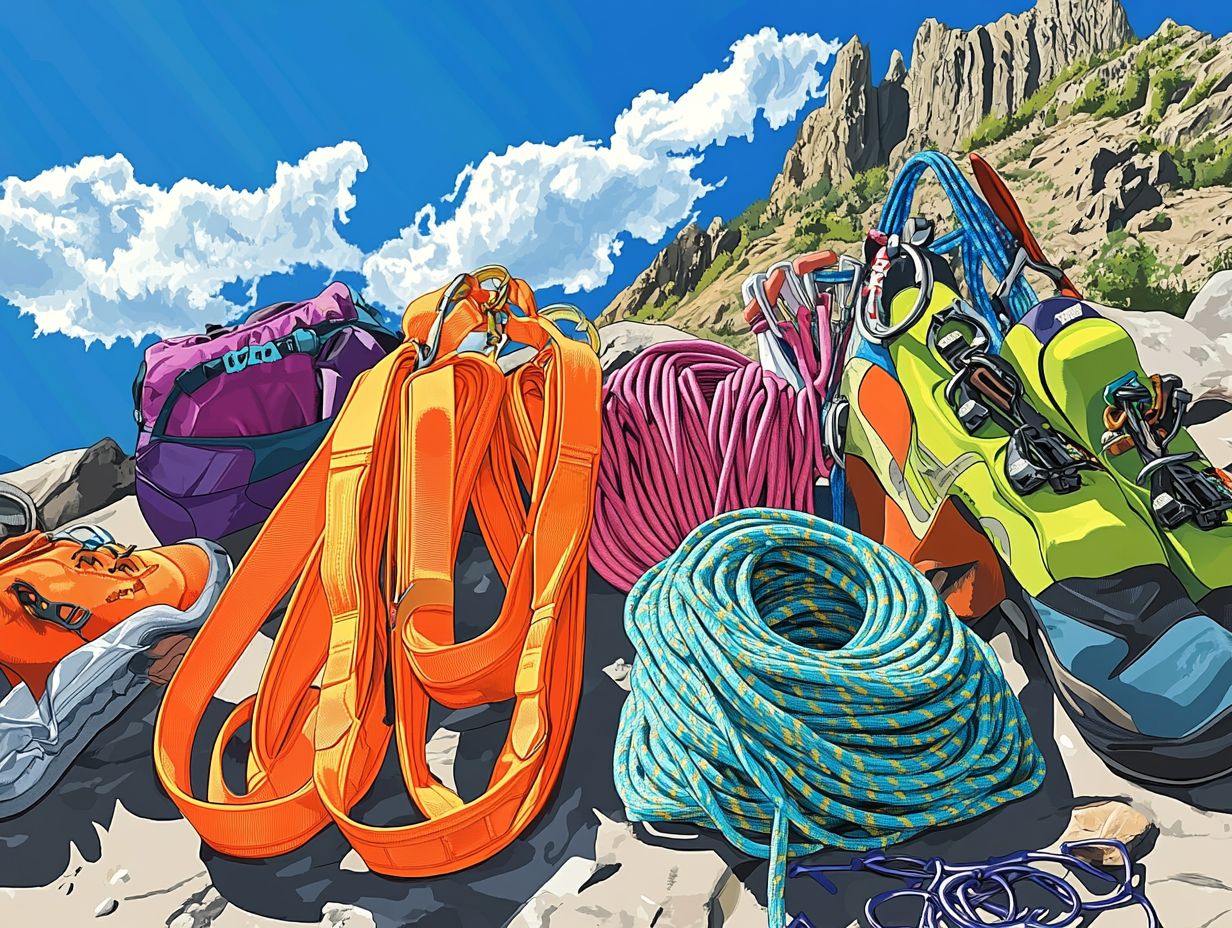
- Invest in quality climbing shoes for different types of terrain and activities.
- A versatile harness with adjustable leg loops is essential for comfort and safety.
- Don’t forget a chalk bag for a better grip and less risk of slipping.
1. Climbing Shoes
Climbing shoes are an essential part of your climbing gear. They are crafted to elevate your performance and deliver the grip, support, and precision you need for various techniques.
With a myriad of styles at your fingertips, you can choose shoes tailored to your unique needs and preferences. For example, aggressive shoes have a pointed toe design for maximum power on steep routes, while moderate shoes offer a comfortable fit for those long, all-day climbs.
The material be it synthetic or leather plays a vital role in breathability and stretch, both essential for that perfect snug fit. The type of rubber used for the sole also impacts traction on different surfaces.
Grasping these features and their influence on performance is crucial in selecting the right climbing shoe; it could very well be the key to your success on the rock face.
2. Harness
A climbing harness is an essential piece of safety equipment that ensures your security while tackling various climbing routes. It provides comfort and support during those long climbs, whether you’re top roping or embarking on alpine adventures.
These harnesses come in a range of types, including sit harnesses that evenly distribute weight and offer ample support. There’s also the harness that goes over your whole body, perfect for specific situations like working at heights or for kids. Each type boasts unique features such as adjustable leg loops and gear loops, catering to your climbing style and personal preferences.
Fitting your harness properly is crucial; it should be snug without being restrictive, allowing you to move freely while keeping safety intact. Choosing the right harness enhances your performance and is vital for tackling different climbing challenges, underscoring the importance of tailored safety gear.
3. Chalk Bag
A chalk bag is a lightweight essential in your climbing gear, designed to help you maintain grip and reduce slippage. This little gem ultimately enhances your performance whether you’re bouldering or tackling sport climbing.
You ll find these bags crafted from various materials like nylon, canvas, and even eco-friendly options, giving you the durability and textures that fit your personal style. Designers have thoughtfully included features such as adjustable waist straps, brush holders, and double cinch closures to meet the unique needs of climbers like you.
Sizes range widely, catering to everyone from minimalists with compact bags to those who prefer larger options that hold more chalk for extended climbs. Using chalk not only boosts friction on holds but also enhances your safety. It allows you to feel secure while navigating challenging routes, significantly reducing the risk of falls and injuries.
4. Belay Device
A belay device is an essential component of your climbing gear, enabling you to manage the rope securely during your ascents. It gives you the power to control your descent and ensure your climbing partner s safety across various scenarios, whether you re tackling sport or trad climbing.
Understanding the different types of belay devices is essential for any climbing enthusiast. These devices fall into several categories, including tube-style, assisted braking, and guide devices, each providing unique mechanisms to control the rope s movement. For example, tube-style devices are lightweight and straightforward, making them perfect for traditional climbing. Assisted braking devices offer an added layer of security by automatically locking the rope in the event of a fall.
Familiarizing yourself with the operation and best practices of your chosen belay device is vital. Mastering proper belaying techniques enhances safety and builds trust between you and your climbing partner.
This ensures that your experiences in the vertical world are both enjoyable and secure.
5. Quickdraws
Quickdraws are an essential part of your climbing gear, serving as the vital link between your climbing rope and the anchors. They enhance your safety and efficiency, especially when tackling sport climbing and challenging routes.
These versatile tools usually consist of two carabiners connected by a durable sling. One carabiner clips onto your climbing rope, while the other secures to a fixed anchor point on the rock face or climbing wall. Quickdraws streamline your rope management, allowing you to clip and unclipping with ease as you ascend. This minimizes the risk of tangling and reduces potential fall distance, making them crucial for your safety.
Using quickdraws properly boosts both your confidence and performance on steep and tricky terrain.
6. Rope
Climbing ropes serve as the backbone of your climbing safety equipment, expertly designed to absorb falls and provide steadfast support. This ensures you have a secure climbing experience whether you re top roping or tackling trad climbing.
When you delve into the world of climbing ropes, it’s essential to distinguish between dynamic and static types. Dynamic ropes are engineered to stretch under load, significantly reducing the impact force during a fall. This makes them your go-to choice for lead climbing and sport climbing. Static ropes lack that stretch and are commonly utilized for rappelling, rescue operations, or hauling gear.
As a climber, consider the specific activities you engage in; each rope type offers unique features tailored to different scenarios. Caring for your climbing ropes is crucial. Regularly inspect them for wear, and tear, clean them properly after use, and store them safely to extend their lifespan, keeping you safe and confident on every climb.
7. Carabiners
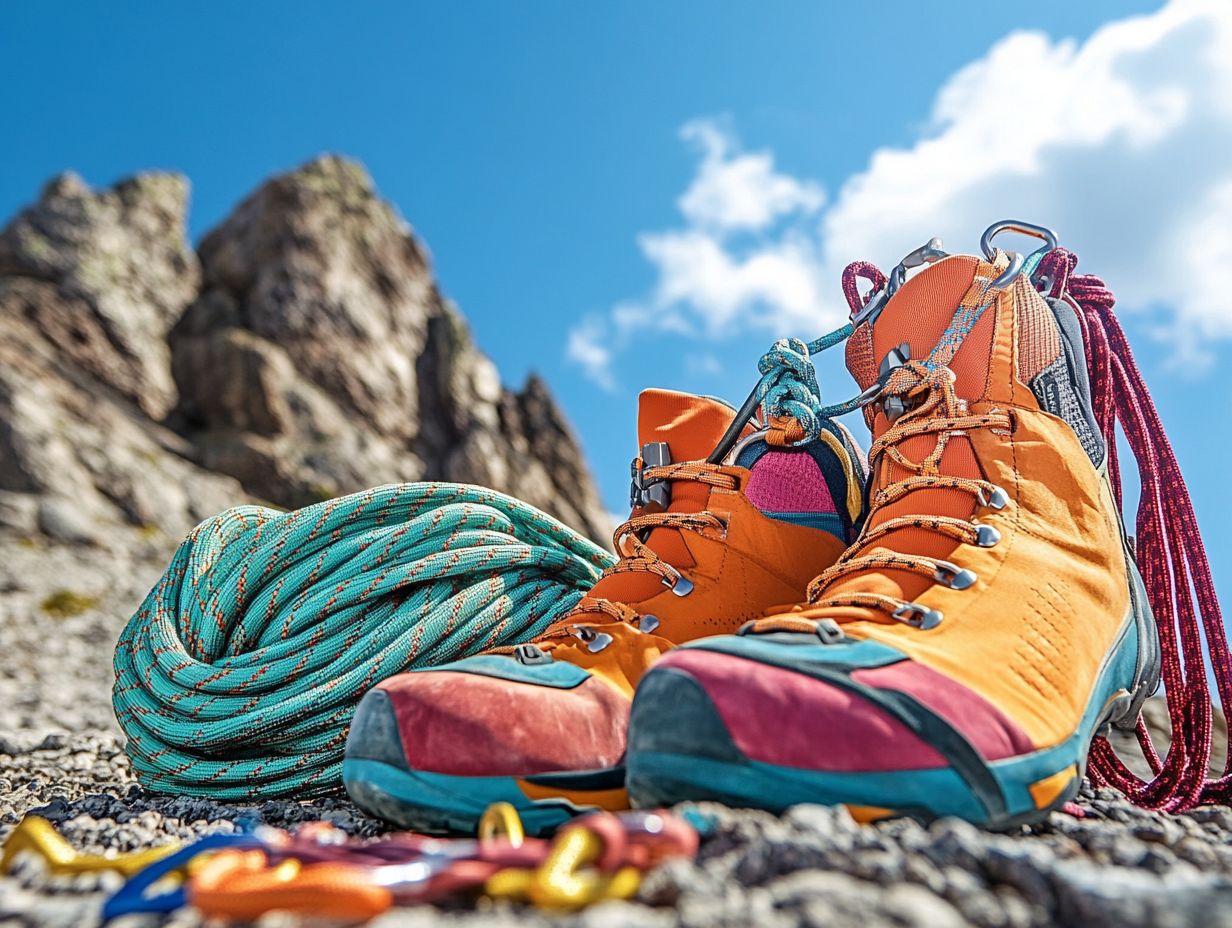
Carabiners are essential pieces of climbing gear for you, serving to connect various components in your climbing systems. When you opt for locking carabiners, you gain an extra layer of safety that keeps your gear secure during climbs and alpine adventures.
On the flip side, non-locking carabiners are typically lighter and more user-friendly, making them the go-to choice when quick access and speed are crucial think sport climbing or setting up topropes. However, remember that while these non-locking options allow for swift maneuvers, they also come with an increased risk of accidental unclipping.
To maintain your carabiners, make it a habit to regularly inspect them for wear, tear, or damage. Proper care includes cleaning them after each use and occasionally lubricating the locking mechanisms to ensure they work smoothly and safely. This way, you can enjoy peace of mind during every ascent.
8. Helmet
A climbing helmet is a must for your climbing adventures! It’s an essential piece of protective gear designed to shield you from potential hazards like falling rocks and impacts. This makes it a cornerstone of climbing safety on any outdoor expedition.
These helmets come in a variety of designs, including hard-shell, foam, and hybrid models. Each type is tailored to different climbing styles and personal preferences. Hard-shell helmets typically offer enhanced durability, while foam helmets are lightweight and exceptionally comfortable for those longer climbs.
Many helmets also feature adjustable straps for a secure fit and ventilation to keep you cool as you ascend. Wearing a helmet is non-negotiable; even a small rock dislodged from above can lead to serious injury.
Choosing the right helmet not only protects your head but also boosts your confidence, allowing you to concentrate on your climb without the distraction of potential dangers.
9. Cams and Nuts
Cams and nuts are important tools for climbing, especially when it comes to traditional climbing, which relies on placing your own gear. These tools serve to create secure anchors and safeguard your ascent. They elevate both your safety and confidence as you navigate challenging routes.
These devices operate by wedging themselves into rock features, effectively catching you if you happen to slip and preventing you from falling too far. Cams are spring-loaded wonders that expand within cracks. Nuts are smaller metal pieces that adapt to various placements based on the rock s unique contours.
Placement is everything; you must carefully assess the rock and position your gear to ensure optimal security. Mastering the use of these tools not only enhances your safety but also deepens your appreciation for the skill and artistry involved in traditional climbing, giving you the power to tackle even more ambitious challenges.
10. Slings and Runners
Slings and runners are invaluable climbing gear that allows you to create anchors and extend protection points while scaling heights. This ensures your safety during those thrilling alpine adventures.
These essential tools come in various lengths and materials tailored for specific climbing scenarios. The most common varieties include nylon and Dyneema slings, a super-strong material used for slings. Each offers unique strengths and flexibility.
Slings are perfect for wrapping around trees or boulders, enabling you to set up anchors swiftly. Runners connect your harness to protection points along your route. By selecting the right type of sling or runner, you can significantly enhance your safety and efficiency.
This gives you the peace of mind you need as you navigate challenging terrains.
11. Climbing Backpack
A climbing backpack is an essential piece of gear that holds your gear and personal items, keeping everything organized for your journey. It ensures that all your essentials are readily accessible when you need them most.
When you’re selecting a climbing backpack, consider features like capacity, durability, and comfort. Look for adjustable straps and a supportive harness system to evenly distribute weight this can make a remarkable difference during long treks.
External attachment points for items like climbing ropes, ice axes, or helmets add a layer of convenience that you ll truly appreciate. To pack efficiently, meticulous organization is crucial. Using a thorough gear checklist ensures you won t leave anything vital behind.
Use each compartment wisely to keep things organized. This makes it easier to grab what you need when you need it.
12. Climbing Pants
Climbing pants are meticulously crafted to elevate your climbing performance, providing both comfort and flexibility while enduring the challenges of rock climbing. They are suitable whether you re tackling bouldering routes or sport climbs.
Made from robust, stretchable materials like nylon or spandex, these essential garments offer the range of motion you need for those intricate maneuvers. The ideal climbing pants should also incorporate breathable fabrics that efficiently wick away moisture, ensuring you remain dry and comfortable during those intense ascents.
Look for options that feature reinforced knees and pockets for gear storage, along with adjustable cuffs to avoid snagging on any protrusions. Achieving the perfect fit is crucial; it allows for unrestricted movement without feeling confining.
This enables you to concentrate fully on your ascent rather than your attire.
13. Climbing Shirt
A climbing shirt is an essential piece of your climbing gear that not only delivers comfort and breathability but also shields you from the sun.
These shirts come in materials like polyester, nylon, or merino wool. Each material has its own advantages. For example, polyester is known for drying quickly, efficiently drawing sweat away from your body and allowing it to evaporate fast. This keeps you dry and comfortable, especially during those challenging ascents.
Many models have built-in UV protection, ensuring your skin is shielded from harmful rays an important consideration when you re out in the sun for hours. With a variety of options available, from lightweight long-sleeved designs to short-sleeved choices, you can select the shirt that best suits your needs and preferences, enhancing your performance and safety on the rock walls.
14. Climbing Gloves
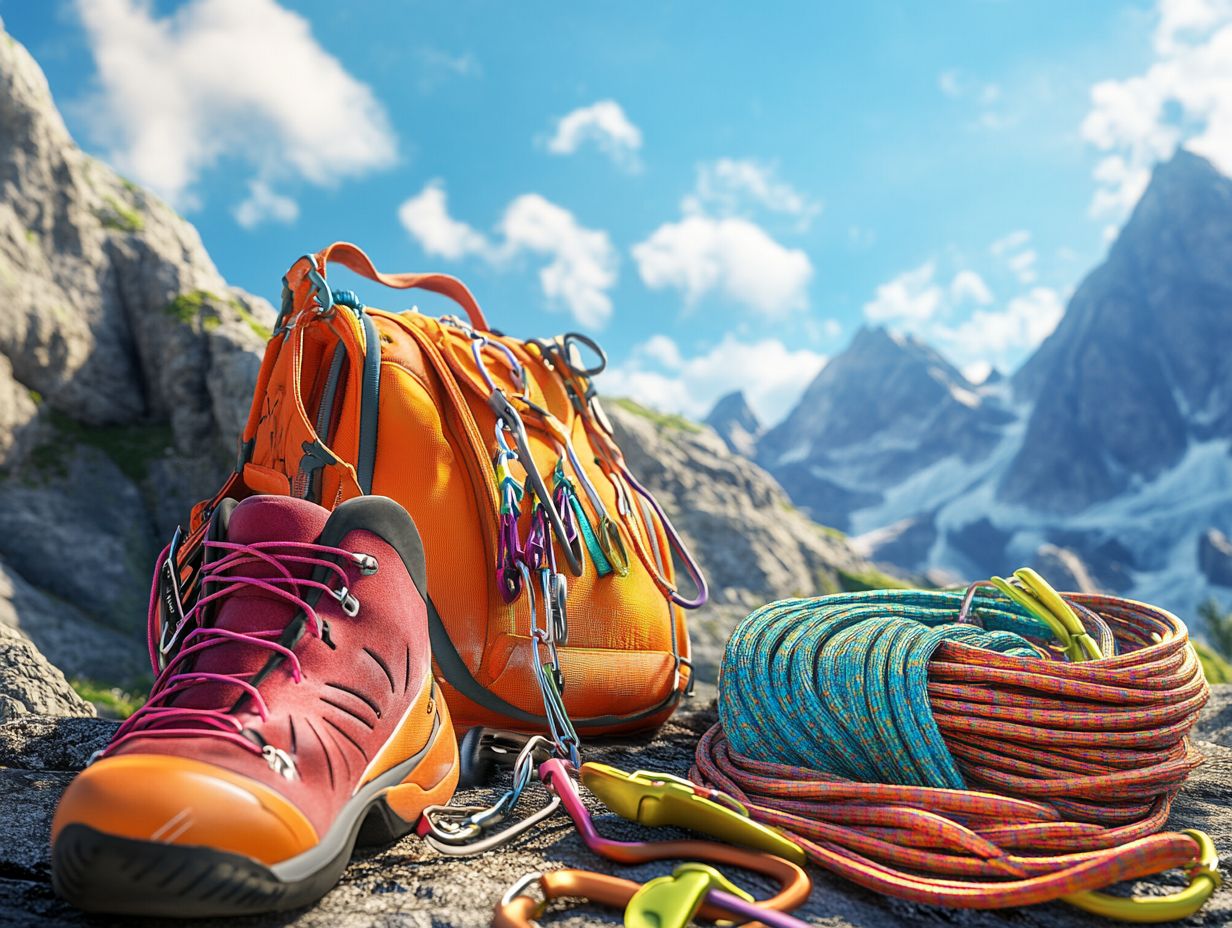
Climbing gloves are a key part of your climbing gear, offering hand protection while enhancing grip and control. These elements are vital for your safety during climbs.
You’ll find various types of climbing gloves tailored to different climbing styles and conditions. Each glove has unique features to optimize your performance. For example, full-finger gloves offer maximum protection and warmth for those chilly ascents. In contrast, fingerless options boost dexterity and tactile feedback, perfect for precision maneuvers on rock faces.
There are also specialized gloves designed for bouldering, focusing on grip to help you maintain control on challenging routes. These gloves protect against abrasions and impacts while improving grip and friction, making them essential for climbers, whether recreational or professional.
Selecting the right pair can significantly enhance your overall performance, ensuring you stay safe as you push your limits.
15. Climbing Helmet
A climbing helmet is an essential piece of protective gear designed to protect you from falling debris and impacts. It significantly enhances your safety whether you’re scaling outdoor cliffs or tackling indoor walls.
This helmet acts as a vital line of defense against various hazards, such as loose rocks and unexpected collisions. When you’re engaged in different styles of climbing be it sport, trad, or bouldering choosing a helmet that fits well and meets your climbing style is super important for your safety.
Opting for lightweight materials and adjustable fit systems can offer comfort while ensuring that your helmet stays securely in place without adding unnecessary bulk. Ultimately, understanding the right features to look for can elevate your experience, allowing you to choose a helmet that feels like a natural extension of your gear rather than a cumbersome accessory.
What Are the Essential Items for Any Climbing Trip?
When you’re gearing up for a climbing trip, having a comprehensive climbing gear checklist is crucial. It ensures you have all the essentials, enhancing both your enjoyment and safety during the adventure.
- Harnesses
- Climbing shoes
- Ropes
- Carabiners
- Weather-appropriate clothing
- First aid kits
- Hydration systems
Don’t overlook personal items; they play a significant role in elevating your overall experience. Safety gear, including helmets and emergency communication devices, is vital for preparing you for any unforeseen circumstances.
Packing your gear ahead of time is essential. It keeps you ready for any adventure that comes your way!
How Can One Determine the Right Gear for Their Climbing Trip?
Determining the right gear for your climbing trip requires a careful assessment of your individual climbing skills, the type of climbing you’re undertaking be it bouldering, sport climbing, or something more adventurous. You also need a clear understanding of the specific requirements of your chosen routes to ensure both safety and optimal performance.
It’s essential to consider your personal preferences concerning comfort and flexibility. Additionally, take into account the environmental conditions you might face, such as temperature fluctuations and moisture levels. For instance, if you’re gearing up for icy terrains, you’ll want to invest in specialized crampons and insulated clothing. If bouldering by the beach is on your agenda, prioritizing a reliable chalk bag and high-quality climbing shoes will be key.
Remember, the variety in harnesses and belay devices is significant and often hinges on your experience level. By carefully evaluating these factors, you can make informed choices that not only enhance your safety but also elevate your overall enjoyment during the ascent.
What Are the Different Types of Climbing Gear?
Climbing gear encompasses a diverse array of equipment meticulously designed for various types of climbing, such as bouldering, sport climbing, trad climbing, and mountaineering. Each of these disciplines demands specific gear to ensure your safety and efficiency.
If you’re into bouldering, you’ll want to invest in crash pads and climbing shoes that provide maximum grip and protection. If sport climbing is more your style, you’ll be relying on harnesses, quickdraws, and ropes for those exhilarating vertical ascents. Trad climbers use devices that help secure climbing gear into rock formations and slings, while mountaineers turn to ice axes and crampons for conquering icy terrains. To learn more about the essential equipment, check out our guide on understanding the different types of climbing gear.
By selecting the right equipment tailored to your specific climbing discipline, you can elevate your performance and significantly minimize the risks tied to your adventurous escapades.
How Can One Properly Maintain and Store Climbing Gear?
Proper maintenance and storage of your climbing gear are essential for ensuring both safety and longevity. Well-maintained equipment not only performs better but also significantly reduces the risk of accidents during your climbs.
Inspect your gear before every adventure to ensure your safety! Regularly check your climbing harnesses, ropes, and carabiners for signs of wear and tear, such as frays, cracks, or any other damage. This simple habit can make all the difference in your safety.
Cleaning your gear after use is critical. Dirt and moisture can compromise the integrity of your equipment, so take the time to use soft brushes and mild soap. Ensure everything dries completely before you tuck it away. Consider using climbing tape for any minor repairs during cleaning.
Also, maintain a dedicated, cool, and dry storage space for your gear. This will help prolong its lifespan and keep it in top condition for every alpine adventure that awaits you.
What Are Some Tips for Packing Climbing Gear for a Trip?
Packing your climbing gear efficiently for a trip requires a meticulous approach within your climbing backpack, ensuring that all essentials are easily accessible while striking the perfect balance between weight and functionality.
To truly optimize your climbing experience, prioritize the items you ll need most frequently. Place them in pockets or compartments that are within easy reach. Consider how you distribute the weight across your backpack; heavier items like climbing shoes should be packed closer to your back for improved stability and reduced strain on your body.
Utilizing gear loops, compression straps, and internal organizers can significantly enhance accessibility. This allows you to swiftly retrieve items like climbing ropes, harnesses, and quickdraws without the hassle of digging through your entire pack. For solo climbers, knowing what is the best gear is essential. This method not only streamlines your experience but also promotes safety, minimizing the time spent searching for crucial gear during critical moments on the ascent.
Frequently Asked Questions
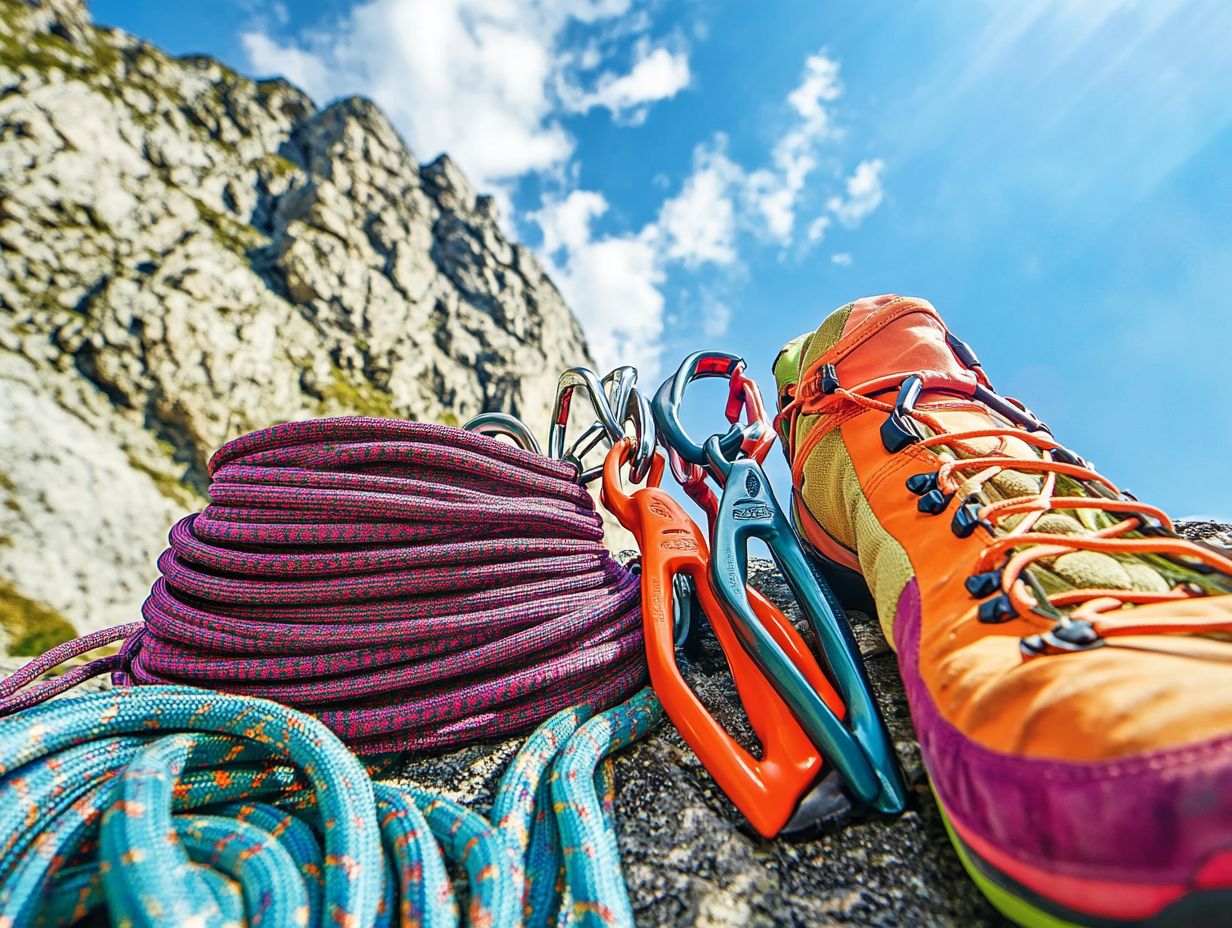
Ready to tackle the climbing world? Gear up and hit the trails!
What is the most versatile climbing gear for any trip?
The most versatile climbing gear includes a combination of a climbing harness, climbing shoes, a chalk bag, quickdraws (devices that connect the rope to protection points), a climbing rope, a climbing helmet, and a belay device.
Do I need different gear for different climbing trips?
It s best to have specific gear for different climbing types, such as sport climbing, trad climbing, or bouldering. A versatile set often works for multiple types of trips.
What should I consider when choosing versatile climbing gear for a trip?
Think about the climbing type you’ll be doing, like top roping or mountaineering. Also, consider the terrain, environment, weight, and durability of the gear.
Is it important to have a versatile climbing harness?
A versatile climbing harness is crucial for any climbing trip. It should be comfortable, adjustable, and suitable for various climbing styles, including sport, trad, and multi-pitch.
Can I use the same climbing shoes for all types of climbing?
You can use the same climbing shoes for different types, but it s better to have specific shoes for sport climbing, trad climbing, and bouldering. This enhances performance and comfort.
What other gear should I consider for a versatile climbing trip?
Don t forget to pack essential items like a climbing pack, a first aid kit, a headlamp, and a multi-tool. These will help you handle unforeseen situations along with sun protection and a gear checklist.

